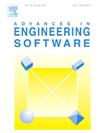Effect of distributed DVAs on stochastic dynamic behaviors of FG-GPLRC annular plates
IF 5.7
2区 工程技术
Q2 COMPUTER SCIENCE, INTERDISCIPLINARY APPLICATIONS
引用次数: 0
Abstract
Based on dynamic vibration absorber (DVA) technology, a hybrid numerical method combining the spectro-geometric method (SGM) and the pseudo-excitation method (PEM) is proposed to analyze the free vibration characteristics and stochastic dynamic behavior of functionally graded graphene platelet-reinforced composites (FG-GPLRC) annular plates under various stationary and nonstationary stochastic excitations. The dynamic model of the DVA is simplified as a spring–mass system. Within the theoretical framework of the first-order shear deformation theory (FSDT), the Lagrangian energy functional of the coupled structure is constructed, and the dynamic response of the coupled system is obtained using the Rayleigh-Ritz variational method. The numerical accuracy of the proposed method is validated by comparing the results with those from existing literature and the finite element method (FEM). On this basis, the effectiveness of DVAs in suppressing structural vibration is demonstrated, and the effects of structural dimensions, material properties, and DVA installation parameters on the dynamic behavior of the coupled system are examined.
分布DVAs对FG-GPLRC环形板随机动力行为的影响
基于动态吸振器(DVA)技术,提出了一种结合光谱几何法(SGM)和伪激励法(PEM)的混合数值方法,分析了功能梯度石墨烯平板增强复合材料(FG-GPLRC)环形板在各种平稳和非平稳随机激励下的自由振动特性和随机动力行为。将DVA的动力学模型简化为弹簧-质量系统。在一阶剪切变形理论(FSDT)的理论框架下,构建了耦合结构的拉格朗日能量泛函,并采用瑞利-里兹变分方法得到了耦合系统的动力响应。通过与已有文献和有限元法计算结果的比较,验证了所提方法的数值精度。在此基础上,论证了DVA抑制结构振动的有效性,并考察了结构尺寸、材料性能和DVA安装参数对耦合系统动力性能的影响。
本文章由计算机程序翻译,如有差异,请以英文原文为准。
求助全文
约1分钟内获得全文
求助全文
来源期刊

Advances in Engineering Software
工程技术-计算机:跨学科应用
CiteScore
7.70
自引率
4.20%
发文量
169
审稿时长
37 days
期刊介绍:
The objective of this journal is to communicate recent and projected advances in computer-based engineering techniques. The fields covered include mechanical, aerospace, civil and environmental engineering, with an emphasis on research and development leading to practical problem-solving.
The scope of the journal includes:
• Innovative computational strategies and numerical algorithms for large-scale engineering problems
• Analysis and simulation techniques and systems
• Model and mesh generation
• Control of the accuracy, stability and efficiency of computational process
• Exploitation of new computing environments (eg distributed hetergeneous and collaborative computing)
• Advanced visualization techniques, virtual environments and prototyping
• Applications of AI, knowledge-based systems, computational intelligence, including fuzzy logic, neural networks and evolutionary computations
• Application of object-oriented technology to engineering problems
• Intelligent human computer interfaces
• Design automation, multidisciplinary design and optimization
• CAD, CAE and integrated process and product development systems
• Quality and reliability.
 求助内容:
求助内容: 应助结果提醒方式:
应助结果提醒方式:


